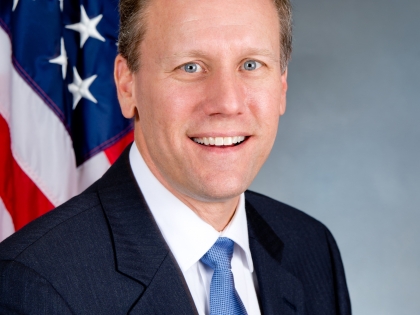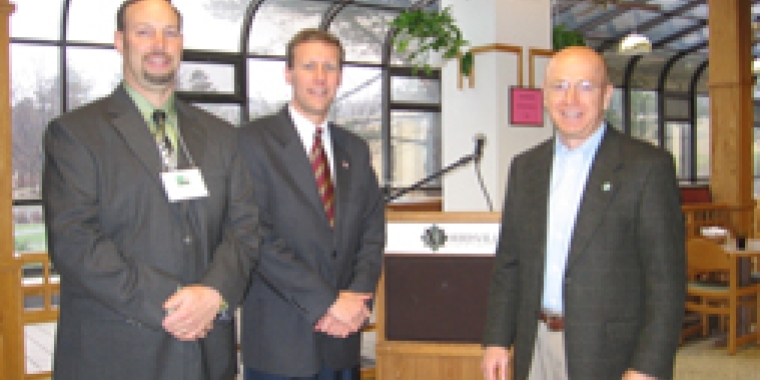
Senator Valesky Speaks At Fallow Land Symposium

Senator Valesky gave the following speech on January 14, 2006 at Morrisville State College. The Senator's briefing on Agriculture was part of a symposium on reclaiming fallow land using livestock as a tool for change and understanding the relationships between the soil seed bank, animal impact, grazing management and the opportunities for landowners and farmers to work together.
Thanks for that welcome. And, of course, thank you President Cross for your kind words. It is always a pleasure to be here with you at Morrisville State College. Whenever I am here I am sure that, because of Ray Cross, I am bound to learn something new.
I’d also like to thank Troy Bishopp for inviting me to speak with you today. I wanted to be here during the lunch hour to see if Troy was going to eat actual goldenrod – as I he has been known to do.
But seriously, this symposium would not have been possible without the hard work, dedication, and drive of one person – the grass whisperer, Troy Bishopp. So, I thank you for making this happen, and for inviting me to speak.
As many of you know, the 49th Senate District which I represent covers all of Madison County, about half of Onondaga County, and parts of Cayuga and Oneida County. Incidentally, the Governor tapped a dairy farmer from Oneida County, Patrick Brennan, to head up Ag and Markets. So, I look forward to working with him.
As you can imagine, the 49th Senate district is quite large and mostly rural. That's why after I was elected, when the leader of my conference told me I could be the ranking member of one committee, I chose agriculture. It just so happens I was appointed ranker of two committees -- Agriculture and Environmental conservation.
While many in Albany saw this as a possible conflict, I know the people in this room understand the link and the common ground between these two important committees. After all, farmers are the first environmentalists.
It was about a year ago that I was named the ranking member of the Agriculture committee. And, admittedly, I had a lot to learn. As you may know, I do not have farming in my background. But, I was born and raised right here in Madison County, with a rich tradition in Agriculture.
I spent the past year visiting, touring and learning. I’ve met with farmers across the district – dairy farmers, alpaca farmers, grain farmers, both big and small. I’ve worked with the Farm Bureau, Cornell Cooperative Extension, and New York FarmNet -- some of the great resources we have here in New York.
I’ve talked with Onondaga County Soil and Water's Mark Burger about water runoff, John Mitchell president of Richer Feeds about grain, and President Cross about Biofuels. I’ve had quite a year – and I have learned a great deal.
I have been looking forward to today for sometime, because knowing Dr. Cross and knowing about Troy, I knew this would be a gathering of creative thinkers who are willing to approach agriculture from new angles and with fresh ideas – people willing to think outside of the box, or even outside the barn.
Some of these ideas may even be based on old and well-established practices. That’s what grazing is, isn’t it? It is a radically new, yet old-fashioned way of accomplishing what we have been perfecting with the science of feed and manure management for so many years.
Ironic, that we consider it radical when Troy Bishopp goes around telling people that we should have livestock eat grass, of all things! We have come full circle.
But this grazing message, which is as straightforward as they come, really has profound implications for all of the efforts underway to make farming sustainable – both environmentally and economically. Because that’s what it’s all about in the end: sustainable, viable farms.
Far too often I get calls from farmers in my district saying they’ve had it. Most often, they are small dairy farmers. They say milk prices are too low, and energy costs are too high. They are a fourth generation farmer, but they just can’t do it any more. And they are getting out.
I do not like to hear it, but I certainly understand it. When milk was selling for $17 a hundredweight, farms were barely getting by. With fuel up, and milk down. It’s breaking them.
We can’t let that happen anymore. We have to do everything we can to find the solutions that will help save the family farm, and preserve, not just a way of life, but this vital component of our state economy.
My state senate colleagues from New York City, are always surprised when I tell them that Agriculture is the number one industry in our state. They look around at their concrete giants and neon lights and cannot fathom that there is more created in our rolling fields than in all the Skyscrapers on Wall Street. But it is true.
When you realize that fact, you can look around at the people in this room and know that what we are talking about today – reclaiming fallow land by grazing livestock -- could hold answers for families who want to keep farming and could also have a major impact on our state economy.
So today, I’d like to talk a little about sustainable, viable farming, and what I believe the state legislature needs to focus on to help this industry and encourage new opportunities.
Before I do that, I’d like to speak briefly about the upcoming budget – because that too could have a great impact on our effort. About this time last year, the governor presented the state legislature with a budget that slashed spending on vital agriculture programs.
One of my first duties as the ranker on Agriculture was to sit on a Senate-Assembly Conference Committee that dealt with these proposed cuts in Agriculture. The final budget that we passed restored funding to many of these important programs.
We were able to restore or add funding for the Farm Viability Institute, for the New York State Apple Growers Association, for programs like Cattle Health Assurance, Quality Milk Promotion, Agriculture in the Classroom, Future Farmers of America, the list goes on and on.
Total additions and restorations by the Committee for agricultural programs came to nearly $8.8 million. This may sound like a lot, but it was essential funding for the agriculture industry and the rural communities I represent. And it was reasonable considering the place Agriculture holds in our state economy.
As a side note, that on-time budget we passed last year also included a cap on the local portion of Medicaid. For those not from around here, New York is one of few states that pass the Medicaid burden down to counties. Last year we took the first step to stop passing the buck and the burden to the counties. Because of it, counties across Central New York were able to cut property taxes for the first time in recent memory. That should help farmers somewhat.
In anticipation of this year’s budget, while I hope the governor shows fiscal discipline in spite of the projected surplus, I also urge him not to cut funding for vital Ag programs and, at the very least, to hold the line on Agricultural spending.
We will see in a few days. And, then we will go to work.
More importantly this year, I am looking forward to hear more details on the governor’s talk about moving toward energy independence.
In recent months I have heard from too many farmers, small businesses and individuals about the sky-rocketing cost of fuel and the challenge it presents.
But, as they say, in every challenge lies an opportunity.
The governor said in the state of the state that the time to prepare for a future powered by clean energy sources is now. And I could not agree more.
Clean, renewable energy will bring several advantages. It will mean more security in the world as we spend less financing the regimes that would do us harm. It will mean more affordable fuel and energy for farmers in the form of wind, solar and biofuels. And, most importantly for all of us, it will mean renewed vitality for the Agriculture industry.
We have all heard about the possibilities for alternative fuel. And now, thanks to inflated prices, we are seeing the necessity for it.
I believe we must do everything possible in the legislature and our communities to encourage the production and use of alternative energy – with a special emphasis on biofuels, like biodiesel, biogas and ethanol.
For anyone who doubts the value of ethanol and worries about what it will mean for feed corn prices, know that I mean all ethanol, from all sources. I also urge you to spend five minutes with Ray Cross talking about these subjects. He won’t just make you a believer. He’s libel to turn you into an investor.
What are the potential economic benefits of developing the smart energy industry in this state? A report this spring by state comptroller Hevesi estimated that just meeting the goals laid out by the Renewable Portfolio Standard will mean an additional 42,000 jobs in New York State.
That doesn’t even begin to take into account what affordable, home-grown energy will mean for all the farmers struggling to make ends meet.
Of course, we should also work to make fuel more affordable today – because you can only tell a farmer that lower prices are coming for so long. That's why, this past fall, the Senate met in a special session and passed several important pieces of legislation that, if implemented, will have the short-term effect of putting dollars back in peoples' pockets.
To immediately help farmers, motorists, and businesses, the Senate passed a cap on the state tax on the sale of gasoline – so that when prices reach a certain point, the taxes will hit a ceiling and not add to the misery.
The package of legislation passed by the Senate included a tax credit to encourage the production and use of biofuels. If passed by the Assembly and signed by the governor, this could help spur growth in this industry.
Still, more needs to be done. For instance, I believe the state should provide tax credits to homeowners who heat their homes using a blend of biodiesel and fuel oil.
The Legislature should also revisit a bill I sponsored this past session encouraging municipalities to invest in renewable energy sources, like solar, wind, and biofuels.
And we should encourage the use of on-sight power generators, like bovine digesters, by reducing the fees farms are charged to connect to the grid.
There are many more steps we can take to encourage the "ag-energy" industry and smart energy in general, and I hope the governor’s plan includes some of these ideas.
We are talking today about using fallow land for grazing. I hope, in the years ahead, we also take some of that fallow land back for willows, soy and corn -- all used to make cleaner, smarter energy with biofuels.
That is the sort of outside the box thinking we need to do as a state and as the collective Ag industry. We have to think, what is next?
Most farmers in this part of the state are small to medium sized dairy farms. These are the very farms we are losing. We certainly need to help these farms with a more equitable MILC (Milk Income Loss Contract) program and by addressing the importation of milk protein concentrates.
But we also have to recognize that these farms are closing because of economics realities beyond our control. We should never give up the fight, but let’s use the rules of economics to our advantage. While so many dairy farms are struggling, there are incredible opportunities in grass-fed beef and in goats. As you will hear next, new immigrant populations across the area want goat meat. It’s up to farmers to sell it to them.
We need to encourage farmers interested in transitioning to these markets.
We also need to continue to encourage direct-to-market farms. This summer, along with the Farm Bureau’s John Wagner and Cornell Cooperative Extension’s Marty Broccolli, I visited North Star Orchard – about 30 minutes from here.
This small farm is taking advantage of the desire so many suburban dwellers have to go visit a farm a few times a year and buy farm fresh products. From hay rides to strawberries to fresh apple fritters, North Star Orchards is showing how diversification and direct-to-market strategies hold great promise for farmers.
This is not for everyone – nor does it have to be. If just a few farmers out there make the leap to grazed livestock, and others raise goats, and others diversify like Northstar Orchards has, while at the same time we clamp down on MPCs and bring about more equitable milk pricing, we will save more dairy farms than we are currently losing.
The answers are out there. Between grazing, biofuels, on-sight power generating bovine digesters, there is no shortage of innovative ways to make farming viable again -- environmentally and economically. We just have to do a better job connecting the dots and bringing our bold ideas forward.
If we do that, if we can just bring some of these "outside of the barn" solutions to the table and address some of the great challenges, I guarantee there will be fewer farmers calling my office saying they are closing down. And that is what all of us really want. Sustainable farms with viable futures and secure families.
So, again. I thank you for inviting me here today. It was a pleasure, and don't forget to Eat Grass!

